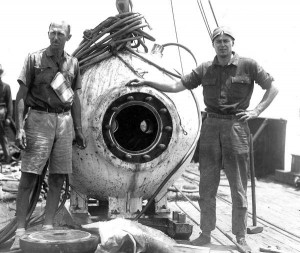Beebe: Exploring Inner Space Off Bermuda
 When Dr. William Beebe’s bathysphere descended to depths of more than half-a-mile off Bermuda in the 1930s, it opened the world of inner space to explorers in much the same way rockets pioneered what President Kennedy called the “high frontier” 30 years later.
When Dr. William Beebe’s bathysphere descended to depths of more than half-a-mile off Bermuda in the 1930s, it opened the world of inner space to explorers in much the same way rockets pioneered what President Kennedy called the “high frontier” 30 years later.
The original, recently restored bathysphere, is now on display at the Coney Island Aquarium and a full-size reproduction of the primitive, five-foot diamater “diving tank” can be found at the Bermuda Underwater Exploration Institute on East Broadway.
The Bermuda dives by Dr. Beebe and his associate and financial backer Otis Barton made front page news around the world and created the same type of popular excitement as Charles Lindbergh’s first solo, non-stop transatlantic flight in 1927.
“What Beebe saw … reported with such vividness was a glowing world of creatures so astonishing that for decades many doubted his veracity,” said one commentator. “The clear sea stretched endlessly, and was so full of luminescence that it sparkled like the night sky.
“Cavalcades of black shrimps, transparent eels, and bizarre fish approached the descending sphere, and when Beebe used his spotlight to see them, great shadows and shifting patches of light hovered just out of view, leading him to postulate the existence of giants in the Bermudian depths.
“And below the bathysphere? There, said Beebe, lay a world that ‘looked like the black pit-mouth of hell itself.”
Footage of the dive is featured in this National Geographic video about Bermuda’s oceans:
Prior to the Bermuda dives in the two-ton steel ball sponsored by the New York Zoological Society, the deepest man had ventured underwater was less than 600 feet.
The bathysphere’s first Bermuda dive was to 800 feet, a record. On June 11, 1930, Beebe and Barton dropped to 1,426 feet.
During the dive, they were connected to the surface by a cable and a telephone hookup, and millions of radio listeners around the world eagerly awaited first-hand reports from the Bermuda depths.
“As they dropped, Beebe took a position at the window, and Barton watched over the instruments and put on the earphones that allowed them to communicate with people on the surface,” says The Encyclopedia of World Biography.
“Beebe commented on each depth; for example, he noted at 383 feet, ‘We are passing the deepest submarine record’, and at 600 feet, ‘Only dead men have sunk below this’.
“Beebe was thrilled to write at a depth of a quarter of a mile, in the pitch-black ocean, ‘A luminous fish is outside the window’.
He later wrote, ‘I knew that I should never again look upon the stars without remembering their active, living counterparts swimming about in that terrific pressure’.
He frequently compared the exploration of the ocean deeps to that of space, and never lost his sense of wonder about being involved in such exploration.”
In 1934 Beebe and Barton descended to a record depth of 3,028 feet; this record was not beaten until 1949.
The American naturalist, ornithologist and explorer died in 1962 at the age of 84. He wrote a number of books about his experiences in Bermuda in the 1920s and ’30s including “Nonsuch, Land of Water” and “Half A Mile Down”.


This was an excellent article and video. Surprised there are not more comments.
@ Boater, I agree this is and excellent article and video, I have only just seen this. My Uncle Gilbert Lamb was one of the locals who worked on the Boat/Barge with Dr. Beebe as well as others. I believe there are picture of these dives (on the Barges deck) at the St David’s Historical Society in Carter House.
I wish I had taped the many conversations we had when I was a young boy about all his seafaring/fishing experiences, ‘Shannon’ was larger than life to say the least.
Amazing how many respected resources confuse the Bahamas with Bermuda on this one…. even Bill Bryson in “A Short History of Nearly Everything” makes this error in chapter 18 “The Bounding Main” where he states that Barton & Beebe’s dives from June 1930 to 1934 were made in the Bahamas!!! Barton apparently made later dives in the Bahamas, which may have caused some of the confusion.